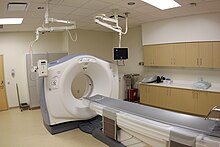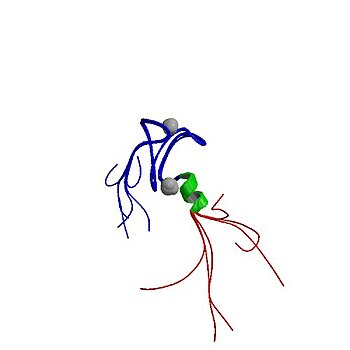Autoimmune polyendocrine syndrome
| Autoimmune polyendocrine syndrome | |
|---|---|
| Other names: Polyglandular autoimmune syndromes Polyendocrine autoimmune syndromes | |
| |
| Types | APS type1, APS type 2, IPEX syndrome |
| Causes | FOXP3 gene is involved in the mechanism [3] |
| Diagnostic method | Endoscopic, CT scan[4] |
| Treatment | Depends on type |
Autoimmune polyendocrine syndromes (APSs), also called polyglandular autoimmune syndromes (PGASs)[5] or polyendocrine autoimmune syndromes (PASs), are a heterogeneous group[6] of rare diseases characterized by autoimmune activity against more than one endocrine organ, although non-endocrine organs can be affected. There are three types of APS, and there are a number of other diseases which involve endocrine autoimmunity.[4][7][8]
Types

- Autoimmune polyendocrine syndrome type 1,[4] an autosomal recessive syndrome due to mutation of the AIRE gene resulting in hypoparathyroidism, adrenal insufficiency, hypogonadism, vitiligo, candidiasis and others.
- Autoimmune polyendocrine syndrome type 2,[9] an autosomal dominant syndrome due to multifactorial gene involvement resulting in adrenal insufficiency plus hypothyroidism and/or type 1 diabetes.
- Immunodysregulation polyendocrinopathy enteropathy X-linked syndrome (IPEX syndrome) is X-linked recessive due to mutation of the FOXP3 gene on the X chromosome. Most develop diabetes and diarrhea and many die due to autoimmune activity against many organs. Boys are affected, while girls are carriers and might suffer mild disease.[4][10][11][12]
Cause
Each "type" of this condition has a different genetic cause. IPEX syndrome is inherited in males by an X-linked recessive process. The FOXP3 gene, whose cytogenetic location is Xp11.23, is involved in the mechanism of the IPEX condition.[13][3]
Diagnosis

Diagnosis for type 1 of this condition for example, sees that the following methods/tests are available:[4]
- Endoscopic
- CT scan
- Histologic test
Differential diagnosis
For this condition, differential diagnosis sees that the following should be considered:[14]
- CD25 deficiency
- STAT5B deficiency
- Severe combined immunodeficiency
- X linked thrombocytopenia
Management

Immunosuppressive therapy may be used in type I of this condition.[15] Ketoconazole can also be used for type I under certain conditions.[4]
The component diseases are managed as usual; the challenge is to detect the possibility of any of the syndromes and to anticipate other manifestations. For example, in a person with known type 2 autoimmune polyendocrine syndrome but no features of Addison's disease, regular screening for antibodies against 21-hydroxylase may prompt early intervention and hydrocortisone replacement to prevent characteristic crises[medical citation needed]
See also
References
- ↑ "Existing Drug Shows Promise as Treatment for Rare Genetic Disorder | NIAID: National Institute of Allergy and Infectious Diseases". www.niaid.nih.gov. 30 May 2024. Archived from the original on 8 July 2024. Retrieved 7 July 2024.
- ↑ Oikonomou, Vasileios; Smith, Grace; Constantine, Gregory M.; Schmitt, Monica M.; Ferré, Elise M. N.; Alejo, Julie C.; Riley, Deanna; Kumar, Dhaneshwar; Dos Santos Dias, Lucas; Pechacek, Joseph; Hadjiyannis, Yannis; Webb, Taura; Seifert, Bryce A.; Ghosh, Rajarshi; Walkiewicz, Magdalena; Martin, Daniel; Besnard, Marine; Snarr, Brendan D.; Deljookorani, Shiva; Lee, Chyi-Chia R.; DiMaggio, Tom; Barber, Princess; Rosen, Lindsey B.; Cheng, Aristine; Rastegar, Andre; de Jesus, Adriana A.; Stoddard, Jennifer; Kuehn, Hye Sun; Break, Timothy J.; Kong, Heidi H.; Castelo-Soccio, Leslie; Colton, Ben; Warner, Blake M.; Kleiner, David E.; Quezado, Martha M.; Davis, Jeremy L.; Fennelly, Kevin P.; Olivier, Kenneth N.; Rosenzweig, Sergio D.; Suffredini, Anthony F.; Anderson, Mark S.; Swidergall, Marc; Guillonneau, Carole; Notarangelo, Luigi D.; Goldbach-Mansky, Raphaela; Neth, Olaf; Monserrat-Garcia, Maria Teresa; Valverde-Fernandez, Justo; Lucena, Jose Manuel; Gomez-Gila, Ana Lucia; Garcia Rojas, Angela; Seppänen, Mikko R. J.; Lohi, Jouko; Hero, Matti; Laakso, Saila; Klemetti, Paula; Lundberg, Vanja; Ekwall, Olov; Olbrich, Peter; Winer, Karen K.; Afzali, Behdad; Moutsopoulos, Niki M.; Holland, Steven M.; Heller, Theo; Pittaluga, Stefania; Lionakis, Michail S. (30 May 2024). "The Role of Interferon-γ in Autoimmune Polyendocrine Syndrome Type 1". The New England Journal of Medicine. 390 (20): 1873–1884. doi:10.1056/NEJMoa2312665. ISSN 1533-4406. Archived from the original on 1 June 2024. Retrieved 7 July 2024.
- ↑ 3.0 3.1 Reference, Genetics Home. "FOXP3 gene". Genetics Home Reference. Archived from the original on 2017-04-17. Retrieved 2017-05-11.
- ↑ 4.0 4.1 4.2 4.3 4.4 4.5 "Type I Polyglandular Autoimmune Syndrome: Background, Pathophysiology, Epidemiology". 2017-01-06. Archived from the original on 2018-04-05. Retrieved 2021-05-23.
{{cite journal}}: Cite journal requires|journal=(help) - ↑ Dittmar, Manuela; Kahaly, George J. (2003). "Polyglandular Autoimmune Syndromes: Immunogenetics and Long-Term Follow-Up". The Journal of Clinical Endocrinology & Metabolism. 88 (7): 2983–2992. doi:10.1210/jc.2002-021845. PMID 12843130. Archived from the original on 13 March 2013. Retrieved 1 July 2013.
- ↑ Eisenbarth GS, Gottlieb PA (2004). "Autoimmune polyendocrine syndromes". N. Engl. J. Med. 350 (20): 2068–79. doi:10.1056/NEJMra030158. PMID 15141045.
- ↑ "Type III Polyglandular Autoimmune Syndrome: Background, Pathophysiology, Epidemiology". 2017-05-03. Archived from the original on 2021-05-10. Retrieved 2021-05-23.
{{cite journal}}: Cite journal requires|journal=(help) - ↑ "Type II Polyglandular Autoimmune Syndrome: Background, Pathophysiology, Epidemiology". 2017-05-03. Archived from the original on 2021-05-11. Retrieved 2021-05-23.
{{cite journal}}: Cite journal requires|journal=(help) - ↑ "Autoimmune polyglandular syndrome type 2 | Genetic and Rare Diseases Information Center (GARD) – an NCATS Program". rarediseases.info.nih.gov. Archived from the original on 2017-04-13. Retrieved 2017-04-20.
- ↑ "IPEX syndrome". Genetics Home Reference. Archived from the original on 2017-04-17. Retrieved 2017-04-20.
- ↑ "Immunodysregulation, polyendocrinopathy and enteropathy X-linked | Genetic and Rare Diseases Information Center (GARD) – an NCATS Program". rarediseases.info.nih.gov. Archived from the original on 2019-01-09. Retrieved 2017-04-20.
- ↑ Wildin, R. S.; Smyk-Pearson, S.; Filipovich, A. H. (1 August 2002). "Clinical and molecular features of the immunodysregulation, polyendocrinopathy, enteropathy, X linked (IPEX) syndrome". Journal of Medical Genetics. 39 (8): 537–545. doi:10.1136/jmg.39.8.537. ISSN 0022-2593. PMC 1735203. PMID 12161590.
- ↑ Reference, Genetics Home. "IPEX syndrome". Genetics Home Reference. Archived from the original on 2017-04-17. Retrieved 2017-05-11.
- ↑ RESERVED, INSERM US14 -- ALL RIGHTS. "Orphanet: Immune dysregulation polyendocrinopathy enteropathy X linked syndrome". www.orpha.net. Archived from the original on 2017-04-19. Retrieved 2017-05-11.
- ↑ Weiler, Fernanda Guimarães; Dias-da-Silva, Magnus R.; Lazaretti-Castro, Marise (2012-02-01). "Autoimmune polyendocrine syndrome type 1: case report and review of literature". Arquivos Brasileiros de Endocrinologia & Metabologia. 56 (1): 54–66. doi:10.1590/S0004-27302012000100009. ISSN 0004-2730. PMID 22460196.
Further reading
- Improda, Nicola; Capalbo, Donatella; Cirillo, Emilia; Cerbone, Manuela; Esposito, Andrea; Pignata, Claudio; Salerno, Mariacarolina (1 November 2014). "Cutaneous vasculitis in patients with autoimmune polyendocrine syndrome type 1: report of a case and brief review of the literature". BMC Pediatrics. 14: 272. doi:10.1186/1471-2431-14-272. ISSN 1471-2431. PMC 4286916. PMID 25361846.
- Shoenfeld, Yehuda; Cervera, Ricard; Gershwin, M. Eric (2008). Diagnostic Criteria in Autoimmune Diseases. Springer Science & Business Media. ISBN 9781603272858. Archived from the original on 2021-04-25. Retrieved 2021-05-23.
External links
- Diseases Database (DDB): 29690
- PubMed Archived 2020-02-10 at the Wayback Machine
| Classification | |
|---|---|
| External resources |
- Pages with script errors
- CS1 errors: missing periodical
- All articles with unsourced statements
- Articles with unsourced statements from May 2017
- Articles with invalid date parameter in template
- Webarchive template wayback links
- Endocrine diseases
- Autoimmune diseases
- Rare syndromes
- Diseases of immune dysregulation

